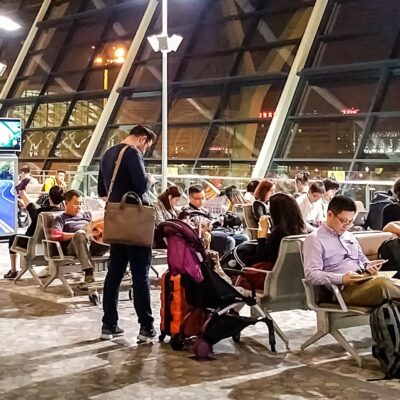The global landscape in the 21st century has been redefined by China’s expanding global footprint economically, politically and culturally.
China’s accession to the World Trade Organisation (WTO) in the early 2000s was a turning point in its transformation into a global trade superpower. China has since overtaken the United States as the most prominent global trade superpower. The process of globalisation has stimulated the socio-economic transformation of China, lifting approximately 800 million people out of poverty; and also redefining global trade integration.
Conventional discourse often portrays China’s global ascent as a coherent, state-driven strategy, exemplified by initiatives such as the Belt and Road Initiative, China’s growing presence in international forums, and global expansion of its state-owned enterprises.
But this special edition of the Melbourne Asia Review explores the expansion of Chinese global influence as a ‘bottom-up’ as well as a ‘top-down’ dynamic—as an assemblage, akin to the concept theorised by philosopher Gilles Deleuze and psychoanalyist Félix Guattari in their influential book “A Thousand Plateaus.” This perspective emphasises dynamic interactions among diverse parts instead of a fixed whole orchestrated by Chinese political will. Global China comprises various components that interact with and impact each other in complex ways.
The heterogeneous nature of the Global China assemblage is far too vast to be fully unpacked in any single edition or monograph. However, this edition aims to illuminate the intriguing, complex, and dynamic nature of Global China by presenting case studies of two major currents underpinning it: resource-rich institutional actors, such as Chinese government agencies and large organisations; and grassroots NGOs, groups, and individuals within Chinese diasporas worldwide.
By examining these contrasting yet complementary pathways, we seek to elucidate how both institutionalised top-down frameworks and bottom-up grassroots dynamics contribute to shaping China’s global influence and the dissemination of China-related knowledge. Through our focus on diverse actors, this collection of articles showcases the varied pathways of Chinese influence across different regions and sectors, shedding new light on China’s global outreach in the contemporary world.
Top-down frameworks
There is currently, perhaps, an unprecedented opportunity for China to exert increasing influence on international governance and transnational arenas as the US, under the second administration of President Donald Trump, further and dramatically withdraws from international agreements and institutions under the guise of its ‘national interest’. An important question arises: Can China fill the void left by the US? Yuk-shing Cheng examines whether China’s ambitions in global governance can be realised in the shifting global order, providing a nuanced perspective on the potential for China to assume a more prominent position in shaping global governance frameworks.
Focusing on China’s transition in recent decades from international aid recipient to contemporary major aid donor, Qing Gu examines the role of the United Nations Development Programme (UNDP) in China’s transition and engagement in global governance. Her analysis underscores how the UNDP has influenced the trajectory of China’s global engagement, mediating between Chinese approaches and international norms.
Andrew Rosser and Randy Nandyatama analyse the Asian Infrastructure Investment Bank (AIIB), often viewed as a tool of Chinese state power, in the context of Indonesia’s Mandalika development project and its displacement of Indigenous peoples. The authors argue that the AIIB risks becoming entangled in a system of governance that prioritises economic returns to capital over human rights and inclusivity. The Mandalika development demonstrates how high level Chinaese policy operates indirectly through institutions and the governments of other nations.
Chuanhong Zhang and Dongwei Wu’s study of Chinese NGOs in international development further exemplifies the intricacy of Global China. Chinese NGOs navigate between state priorities, local needs, and global norms, sometimes reinforcing and sometimes challenging existing power structures. Their work shows how non-state actors contribute to the construction of Global China in ways that may align with or diverge from official state policies.
Bottom-up grassroots dynamics
Yiran Tian and Tianlong You examine diverse manifestations of Global China’s aid in the context of Chinese NGO workers on the Myanmar border. The workers’ daily negotiations with local communities, government agencies, and transnational NGOs reveal a Global China far removed from high-level diplomacy, yet with potentially significant long-term positive impact on particularly vulnerable communities. These social workers and NGOs skillfully transcend sometimes opposing Chinese and international objectives, demonstrating the interconnectedness of Chinese civil society with global civil society.
Other articles in this edition examine Chinese diaspora communities facilitating flows of capital, goods, people, and culture while navigating complex identity politics. This multifaceted phenomenon operates as a transnational network, shaping lived realities across various contexts in ways that are a critical aspect of Global China, but which often elude traditional state-centric analyses.
Liang Chen’s research on Chinese expatriates in Botswana illuminates the multifaceted nature of Chinese diaspora there and the positive and negative impact of Chinese businesses on local workers. Ka ling Cheung and Jennifer Day look at Chinese investors in Vanuatu involved in conflict over land rights with customary landowners.
The cultural dimension of Global China’s diaspora is vividly illustrated in Alice Y.C. Wong’s study of Chinese Peruvian chefs and restaurateurs. The evolution of “Chifa” from a marginalised immigrant cuisine to an integral part of Peru’s national culinary identity demonstrates how Chinese cultural elements are transplanted, adapted, and reimagined in diverse local contexts.
Eric (Jun) Fu et al. make a powerful argument for moving beyond binary frameworks of ‘Chinese’ versus ‘Western’ identities in the context of Chinese international students in Western nations such as Australia. While often defined as instruments of China’s global public diplomacy, the students’ own subjectivities, roles, and experiences as active agents in transnational knowledge networks deserve greater understanding.
My own research on the transformation of Chinese migrant communities in Australia since the early 1990s also demonstrates the complex assemblage that is Global China. The Chinese diaspora in Australia are among those most affected by Chinese government policy as well as geo-political and geo-economic relations, but they have also profited from China’s global ascent and actively contribute to the economic and cultural impact of Global China.
Many Chinese community members I interviewed after the signing of the China-Australia Free Trade Agreement (ChAFTA) in 2015 were excited about the possibilities of exporting more Australian products such as wine and beef. However, as the government let by Scott Morrison (2018-2022) shifted towards a more confrontational approach to China, China imposed significant punitive tariffs on Australian products. While tariffs were officially removed in April 2024, the situation propelled many Chinese Australians to reconsider their entrepreneurial practices and also their China-related engagement in general. Since the introduction of Australia’s foreign interference law in 2018 transnational ties are increasingly viewed through the lens of political, security, and legal risks. Meanwhile, Chinese Australians, regardless of their highly diversified and even contradictory stances regarding China, are often in the discursive frameworks and geopolitical narratives surrounding China’s global rise, becoming part of Global China at the grassroots level.
As the Trump administration destablises world trade and the existing global international order, it is more important than ever to have a nuanced understanding of Global China. Yu Tao and Monica Tan’s exploration of China Studies in Indonesia emphasises this, revealing how local scholars and institutions mediate global knowledge production about China, shaping perceptions and policies in ways that defy simple North-South or East-West dichotomies.
Contributors to this edition bring together both the more well-known institutions and lesser-known grassroots actors in the making of Global China, thereby expanding our understanding of a range of social changes and dynamics. We therefore conceptualise Global China not as a monolithic entity, but as an evolving assemblage of diverse elements—state-driven and grassroots, human and non-human, material and discursive—that come together in various configurations across different contexts, contributing to its growing global footprint.
Recognising the complexity of Global China doesn’t mean ignoring power imbalances or glossing over conflicts. If anything, understanding Global China as an evolving assemblage is to appreciate the dynamic agency and positionality of diverse actors operating in transnational spaces, and to recognise the various implications that arise from their interactions.
Readers interested in understanding broader changes induced by or associated with Global China can refer to Melbourne Asia Review’s interview with one of the foremost experts on Global China, Ching Kwan Lee. Her edited book series, the Global China series, published by Cambridge University Press, also provides concise volumes that examine intriguing topics, such as China and the Global Economic Order, Global Civil Society and China, Global China as Method, and China and Global Food Security.
Image: People standing by a busy road in Shanghai with timelapse image of traffic. Photo by zhang kaiyv, Pexels.




